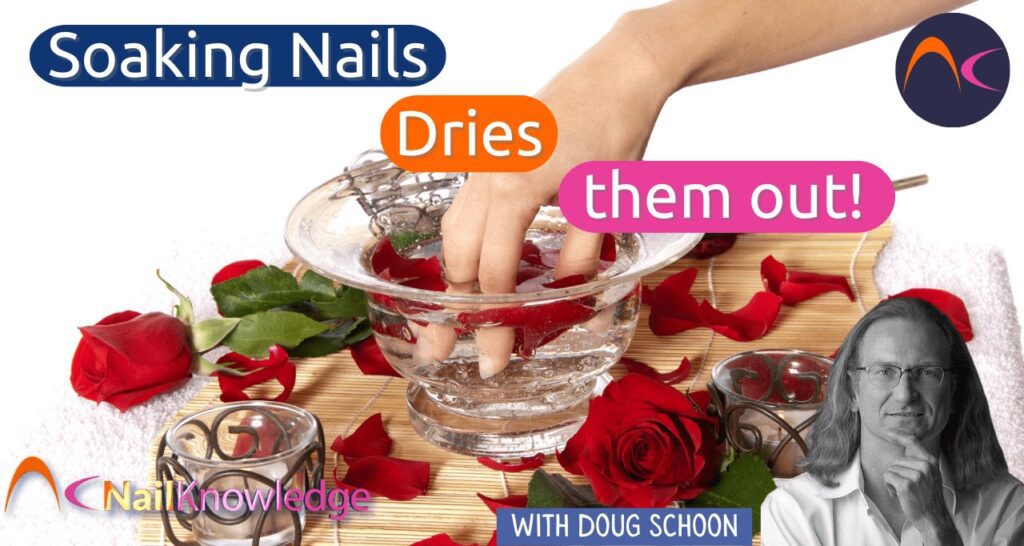It is a very common misunderstanding that soaking the nails dries them out. How can soaking the nails in water make them dry?
That makes no sense. Water cannot cause anything to become dry. Extra water inside the nail plate causes it to become wetter. If the extra water leaves, the nail plate returns to its normal levels of moisture. The plate always contains some moisture, which is the same as saying it contains water. I think what your teacher was trying to say is that excessive water exposure can damage some nail plates when they are repeatedly exposed to water and then dried out again.
Differentiating Damage from Dryness in Nail Plates
When the nail plate absorbs water, it swells to accommodate the extra water molecules that have crowded between the layers of the nail plate. Soaking in water for more than sixty seconds allows water molecules to seep between the layers of nail cells and sheath them in this liquid lubricant. Now the layers can slide past each other with greater ease, making the nail plate easier to bend. A similar effect is seen when hair absorbs water, it becomes much easier to stretch without breaking.
The Swelling Effect: Nail Plate and Water Absorption
When the nail plate absorbs water, it swells to accommodate the extra water molecules that have crowded between the layers of the nail plate. Soaking in water for more than sixty seconds allows water molecules to seep between the layers of nail cells and sheath them in this liquid lubricant. Now the layers can slide past each other with greater ease, making the nail plate easier to bend. A similar effect is seen when hair absorbs water, it becomes much easier to stretch without breaking.
Vulnerability of Softened Nail Plates: Surface Damage and Causes
Absorbed water causes the plate to swell, which may cause cracks to grow. Absorbed water will also make the nail plate’s surface softer and much easier to damage. The softer the nail’s surface, the more prone it will be to scratching, pitting, flaking, and peeling. softened nail plates are easier to damage by physical actions such as prying, picking, scraping, filing, etc. When nail plates are softened by soaking in water, surface damage to the nail is more likely to occur. Water gets the blame, but heavy handed nail techs usually cause much of the surface damage.
A good general rule to remember is, “when a nail plate is soaked in water or other solvents for more than sixty seconds, expect its surface to be more susceptible to damage for the next hour”. Be Cautious!
Precautions for Damaged Nails: Water Absorption and Swelling
Hand washing for fifteen to twenty seconds is not expected to add excessive amounts of water to a nail plate. To help maintain appropriate levels of cleanliness in nail salons and services, clients should always wash their hands before receiving any type of nail service. Although healthy nails are generally resistant to the effects of water; when previously damaged nails are soaked in water for more than a few minutes they can more quickly absorb excessive amounts of water and can swell the nail plate. When the nail plate swells, this worsens existing cracks or splits, which can weaken the nail plate. Of course, this could also be what your teacher was referring to when she said water dried out the nail. Using proper terminology is important for any profession and the nail industry is no exception.
Please help with this issue and always strive to use proper and professional nail terminology- this facilitates better understanding.
FAQs
1. Can soaking nails in water actually dry them out?
No, soaking nails in water does not dry them out. Water does not have the ability to cause dryness. Instead, excessive water exposure can lead to other forms of damage to the nail plate.
2. How does excessive water exposure affect the nail plate?
Excessive water exposure can cause the nail plate to swell as it absorbs water molecules. This swelling can lead to the growth of cracks and weaken the nail plate. Additionally, the absorbed water softens the nail’s surface, making it more prone to scratching, flaking, and peeling.
3. Does water damage to the nail plate resemble dryness?
Water damage to the nail plate is often mistaken for dryness, even though they are not the same. The nail plate may have the same water content as before, but the surface damage becomes more visible, giving the appearance of dryness.
4. Why does water make the nail plate easier to bend?
When the nail plate absorbs water, it swells and the water molecules fill the gaps between the layers of the nail cells. This makes the layers slide past each other more easily, resulting in increased flexibility of the nail plate.
5. What precautions should be taken to prevent surface damage to softened nail plates?
To prevent surface damage to softened nail plates, it is important to handle them with care. Avoid activities such as prying, picking, scraping, or filing the nails aggressively. After soaking the nail plate in water or solvents for more than sixty seconds, expect its surface to be more susceptible to damage for the next hour. Being cautious and using proper nail terminology facilitates better understanding and communication within the nail industry.


